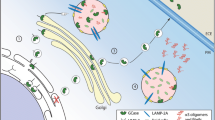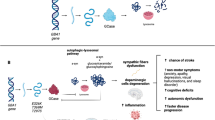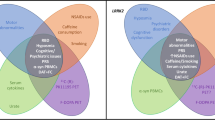Abstract
Background/methods
Monogenic diseases are important models for the study of neurodegenerative diseases, such as Parkinson’s disease (PD) and dementia. Notably, for some disorders, homozygosity is associated with a complex metabolic disease, while heterozygosity predisposes to late-onset neurodegeneration. For instance, biallelic glucocerebrosidase gene mutations cause Gaucher’s disease, while heterozygous mutations are a common genetic risk factor for late-onset PD. Little is known about similar risks of related diseases, such as Niemann–Pick type C (NPC). Given that both conditions map into related, i.e., lysosomal, pathways, we hypothesize a similar risk of single-NPC gene mutations. Indeed, there is increasing evidence based on clinical observations in humans and animal studies. Here we review the current knowledge of NPC heterozygosity.
Results
Family history studies suggest a high proportion of late-onset neurodegenerative diseases in NPC families. We identified 19 cases with heterozygous NPC mutations in the literature who presented with a neurodegenerative disease, including levodopa-responsive PD, atypical parkinsonism (PSP, CBD), dystonia or dementia with a mean age at onset of about 57 years (range 8–87). Consistent splenomegaly and mildly abnormal filipin staining results have also been reported in heterozygous gene mutation carriers. Imaging and pathological data support this notion.
Discussion/conclusion
This finding has wider implications in so far as NPC-related forms of Parkinsonian syndromes, dementia, motor neuron disease and other neurodegenerative disorders may benefit from NPC-mechanistic therapies, in particular related to lysosomal dysfunction. Further research is warranted to generate systematic data of heterozygous mutation carriers, including longitudinal data.


Similar content being viewed by others
References
Hruska KS, LaMarca ME, Scott CR, Sidransky E (2008) Gaucher disease: mutation and polymorphism spectrum in the glucocerebrosidase gene (GBA). Hum Mut 29:567–583
Sidransky E, Samaddar T, Tayebi N (2009) Mutations in GBA are associated with familial Parkinson disease susceptibility and age at onset. Neurology 73:1424–1425 (author reply 1425-1426)
Sidransky E, Lopez G (2012) The link between the GBA gene and parkinsonism. Lancet Neurol 11:986–998
van Swieten JC, Heutink P (2008) Mutations in progranulin (GRN) within the spectrum of clinical and pathological phenotypes of frontotemporal dementia. Lancet Neurol 7:965–974
Arrant AE, Onyilo VC, Unger DE, Roberson ED (2018) Progranulin gene therapy improves lysosomal dysfunction and microglial pathology associated with frontotemporal dementia and neuronal ceroid lipofuscinosis. J Neurosci 38:2341–2358
Robak LA, Jansen IE, van Rooij J et al (2017) Excessive burden of lysosomal storage disorder gene variants in Parkinson’s disease. Brain J Neurol 140:3191–3203
Kresojevic N, Dobricic V, Svetel M, Kostic V (2014) Mutations in Niemann Pick type C gene are risk factor for Alzheimer’s disease. Med Hypotheses 83:559–562
Vanier MT (2013) Niemann–Pick diseases. Handb Clin Neurol 113:1717–1721
Vanier MT, Millat G (2003) Niemann–Pick disease type C. Clin Genet 64:269–281
Malnar MH, Mattsson N, Zetterberg H (2014) Bidirectional link between Alzheimer’s disease and Niemann–Pick type C disease. Neurobiol Dis 72:37–47
Lloyd-Evans EPFM (2010) Lipids on trial: the search for the offending metabolite in Niemann Pick type C disease. Traffic 11:19–28
Patterson MC, Hendriksz CJ, Walterfang M, Sedel F, Vanier MT, Wijburg F (2012) Recommendations for the diagnosis and management of Niemann–Pick disease type C: an update. Mol Genet Metab 106:330–344
Patterson MC, Clayton P, Gissen P et al (2017) Recommendations for the detection and diagnosis of Niemann–Pick disease type C: an update. Neurol Clin Pract 7:499–511
Strupp M, Kremmyda O, Adamczyk C et al (2014) Central ocular motor disorders, including gaze palsy and nystagmus. J Neurol 261(Suppl 2):S542–558
Heitz C, Epelbaum S, Nadjar Y (2017) Cognitive impairment profile in adult patients with Niemann pick type C disease. Orphanet J Rare Dis 12:166
Dvorakova L, Sikora J, Hrebicek M et al (2006) Subclinical course of adult visceral Niemann–Pick type C1 disease. A rare or underdiagnosed disorder? J Inherit Metab Dis 29:591
Schneider SA, Talelli P, Cheeran B, et al (2008) Motor cortical physiology in patients and asymptomatic carriers of parkin gene mutations. Mov Disord (in press)
Hagenah JM, Becker B, Bruggemann N et al (2008) Transcranial sonography findings in a large family with homozygous and heterozygous PINK1 mutations. J Neurol Neurosurg Psychiatry 79:1071–1074
Weissbach A, Baumer T, Pramstaller PP et al (2017) Abnormal premotor-motor interaction in heterozygous Parkin- and Pink1 mutation carriers. Clin Neurophysiol 128:275–280
McNeill A, Duran R, Proukakis C et al (2012) Hyposmia and cognitive impairment in Gaucher disease patients and carriers. Mov Disord 27:526–532
Beavan M, McNeill A, Proukakis C, Hughes DA, Mehta A, Schapira AH (2015) Evolution of prodromal clinical markers of Parkinson disease in a GBA mutation-positive cohort. JAMA Neurol 72:201–208
Cupidi C, Frangipane F, Gallo M et al (2017) Role of Niemann–Pick Type C disease mutations in dementia. J Alzheimers Dis 55:1249–1259
Benussi A, Cotelli MS, Cantoni V et al (2019) Clinical and neurophysiological characteristics of heterozygous NPC1 carriers. JIMD Rep 49:80–88
Bremova TSC, Brendel M, Moser M, Möller B, Clevert DA, Beck-Wödl S, Kun-Rodrigues C, Bras J, Rominger J, Ninov D, Strupp M, Schneider SA. The clinical, ocular motor and imaging profile of Niemann Pick type C heterozygosity. under revision (in press)
Kluenemann HH, Nutt JG, Davis MY, Bird TD (2013) Parkinsonism syndrome in heterozygotes for Niemann–Pick C1. J Neurol Sci 335:219–220
Harzer K, Beck-Wodl S, Bauer P (2014) Niemann–pick disease type C: new aspects in a long published family-partial manifestations in heterozygotes. JIMD Rep 12:25–29
Bremova T, Sztatecsny C, Moser M, Rominger A, Stephan T, Havla J, Hartmann K, Clevert D, Strupp M, Schneider SA (2018) Does Niemann Pick Type C heterozygosity predispose to late-onset neurodegeneration? Mov Disord 33(suppl 2)
Kruth HS, Comly ME, Butler JD et al (1986) Type C Niemann–Pick disease. Abnormal metabolism of low density lipoprotein in homozygous and heterozygous fibroblasts. J Biol Chem. 261:16769–16774
Benussi A, Cotelli MS, Cosseddu M et al (2017) Preliminary results on long-term potentiation-like cortical plasticity and cholinergic dysfunction after miglustat treatment in Niemann–Pick disease type C. JIMD Rep 36:19–27
Zech M, Nubling G, Castrop F et al (2013) Niemann–Pick C disease gene mutations and age-related neurodegenerative disorders. PLoS One 8:e82879
Erickson RPLTK, Weberg L et al (2008) Variation in NPC1, the gene encoding Niemann–Pick C1, a protein involved in intracellular cholesterol transport, is associated with Alzheimer disease and/or aging in the Polish population. Neurosci Lett 447:153–157
Liu XCR, Verbitsky M et al (2011) Genome-wide association study identifies candidate genes for Parkinson’s disease in an Ashkenazi Jewish population. BMC Med Genet 12:104
Bauer PBDJ, Kluenemann HH, Linden DE, Ory DS, Pineda M, Priller J, Sedel F, Muller A, Chadha-Boreham H, Welford RW, Strasser DS, Patterson MC (2013) Genetic screening for Niemann–Pick disease type C in adults with neurological and psychiatric symptoms: findings from the ZOOM study. Hum Mol Genet 22:4349–4356
Boenzi S, Dardis A, Russo P et al (2019) Screening for Niemann–Pick type C disease in neurodegenerative diseases. J Clin Neurosci 68:266–267
Rodriguez-Rodriguez E, Vazquez-Higuera JL, Sanchez-Juan P et al (2010) Epistasis between intracellular cholesterol trafficking-related genes (NPC1 and ABCA1) and Alzheimer’s disease risk. J Alzheimers Dis 21:619–625
Probert F, Ruiz-Rodado V, Vruchte DT et al (2017) NMR analysis reveals significant differences in the plasma metabolic profiles of Niemann Pick C1 patients, heterozygous carriers, and healthy controls. Sci Rep 7:6320
Cougnoux A, Drummond RA, et al (2018) Microglia activation in Niemann–Pick Disease, type C1 is amendable to therapeutic intervention. Hum Mol Genet 27(12):2076–2089
Vanier MT, Gissen P, Bauer P et al (2016) Diagnostic tests for Niemann–Pick disease type C (NP-C): a critical review. Mol Genet Metab 118:244–254
Masingue M, Adanyeguh I, Nadjar Y, Sedel F, Galanaud D, Mochel F (2017) Evolution of structural neuroimaging biomarkers in a series of adult patients with Niemann–Pick type C under treatment. Orphanet J Rare Dis 12:22
Benussi A, Alberici A, Premi E et al (2015) Phenotypic heterogeneity of Niemann–Pick disease type C in monozygotic twins. J Neurol 262:642–647
Huang JY, Peng SF, Yang CC, Yen KY, Tzen KY, Yen RF (2011) Neuroimaging findings in a brain with Niemann–Pick type C disease. J Formos Med Assoc 110:537–542
Kumar A, Chugani HT (2011) Niemann–Pick disease type C: unique 2-deoxy-2[(1)(8)F] fluoro-d-glucose PET abnormality. Pediatr Neurol 44:57–60
Castro-Fernandez CG-SC, Rodriguez-Sureda V, Martinez-Regueiro R, Aguiar P, Blanco-Arias P, Perez-Sousa C, Diaz P, Dominguez C (2016) A heterozygous splicing variant in NPC2 in a patient with PSP. Mov Disord 31 (suppl 2)
Nixon RA (2004) Niemann–Pick Type C disease and Alzheimer’s disease: the APP-endosome connection fattens up. Am J Pathol 164:757–761
Love S, Bridges LR, Case CP (1995) Neurofibrillary tangles in Niemann–Pick disease type C. Brain J Neurol 118(Pt 1):119–129
Auer IA, Schmidt ML, Lee VM et al (1995) Paired helical filament tau (PHFtau) in Niemann–Pick type C disease is similar to PHFtau in Alzheimer’s disease. Acta Neuropathol 90:547–551
Chiba Y, Komori H, Takei S et al (2014) Niemann–Pick disease type C1 predominantly involving the frontotemporal region, with cortical and brainstem Lewy bodies: an autopsy case. Neuropathology 34:49–57
Loftus SKMJA, Carstea ED, Cummings C, Brown A, Ellison J, Ohno K, Rosenfeld MA et al (1997) Murine model of Niemann–Pick C disease: mutation in a cholesterol homeostasis gene. Science 277:232–235
Platt NSAO, Colaco A, Gray J, Smith DA, Williams IM, Wallorn KL, Platt FM (2016) Immune dysfunction in Niemann–Pick disease type C. J Neurochem 136:74–80
Loftus SKERP, Walkley SU, Bryant MA, Incao A, Heidenreich RA et al (2002) Rescue of neurodegeneration in Niemann–Pick C mice by a prion-promotor-driven Npc1 cDNA transgene. Hum Mol Genet 11:3107–3114
Praggastis MTB, Zhang J, Fujiwara H, Sidhu R, Chacko A, Chen Z et al (2015) A murine Niemann Pick C1 I1061T knock-in model recapitulates the pathological features of the most prevalent human disease allele. J Neurosci 35:8091–8106
Yan XYF, Lukas J, Witt M, Wree A, Rolfs A, Luo J (2014) Hyperactive glial cells contribute to axonal pathology in the sinal cord of Npc1 mutant mice. Glia 62:1024–1040
Yu TLAP (2013) Npc1 acting in neurons and glia is essential for the formation and maintenance of CNS myelin. PLoS Genet 9:e1003462
Luan Z, Saito Y, Miyata H, Ohama E, Ninomiya H, Ohno K (2008) Brainstem neuropathology in a mouse model of Niemann–Pick disease type C. J Neurol Sci 268:108–116
Glockner F, Ohm TG (2014) Tau pathology induces intraneuronal cholesterol accumulation. J Neuropathol Exp Neurol 73:846–854
Fu R, Yanjanin NM, Elrick MJ, Ware C, Lieberman AP, Porter FD (2012) Apolipoprotein E genotype and neurological disease onset in Niemann–Pick disease, type C1. Am J Med Genet Part A 158A:2775–2780
Götzl JKMK, Damme M, Fellerer K, Tahirovic S, Kleinberger G, Janssens J, van der Zee J et al (2014) Common pathobiochemical hallmarks of progranulin-associated frontotemporal lobar degeneration and neuronal ceroid lipofuscinosis. Acta Neuropathol 127:845–860
Evers BMR-NC, Tesla RJ, Prange-Kiel J, Wasser CR, Yoo KS, McDonald J et al (2017) Lipidomic and trascriptomic basis of lysosomal dysfunction in progranulin deficiency. Cell Reports. 20:2565–2574
Thareswhar AKTJ, Vermeire W, Pauwels J, Sannerud R, Priestman DA et al (2017) A novel approach to analyze lysosomal dysfunction through subcellular proteomics and lipidomics: the case of NPC1 deficiency. Sci Rep 7:41408
Sarkar SCB, Buganim Y, Maetzel D, Ng AH, Cassady JP et al (2013) Impaired autophagy in the lipid-storage disorder Niemann–Pick type C1 disease. Cell Reports 5:1302–1315
Elrick MJYT, Chung C, Lieberman AP (2012) Impaired proteolysis underlies autophagic dysfunction in Niemann–Pick type C disease. Hum Mol Genet 21:4876–4887
Liao GWZ, Irizarry K, Huang Y, Mitsouras K, Darmani M, Leon T et al (2010) Abnormal gene expression in cerebellum of Npc1 -/- mice during postnatal development. Brain Res 1325:128–140
Somers KL, Royals MA, Carstea ED, Rafi MA, Wenger DA, Thrall MA (2003) Mutation analysis of feline Niemann–Pick C1 disease. Mol Genet Metab 79:99–103
Brown DE, Thrall MA, Walkley SU et al (1996) Metabolic abnormalities in feline Niemann–Pick type C heterozygotes. J Inherit Metab Dis 19:319–330
Lill CM, Rengmark A, Pihlstrom L et al (2015) The role of TREM2 R47H as a risk factor for Alzheimer’s disease, frontotemporal lobar degeneration, amyotrophic lateral sclerosis, and Parkinson’s disease. Alzheimers Dement 11:1407–1416
Schneider SA, Alcalay RN (2017) Neuropathology of genetic synucleinopathies with parkinsonism: review of the literature. Mov Disord 32:1504–1523
Gan-Or Z, Orr-Urtreger A, Alcalay RN, Bressman S, Giladi N, Rouleau GA (2015) The emerging role of SMPD1 mutations in Parkinson’s disease: implications for future studies. Parkinsonism Relat Disord 21:1294–1295
Foo JN, Liany H, Bei JX et al (2013) Rare lysosomal enzyme gene SMPD1 variant (p.R591C) associates with Parkinson’s disease. Neurobiol Aging 34:2890 e2813-2895
McGlinchey RP, Lee JC (2015) Cysteine cathepsins are essential in lysosomal degradation of alpha-synuclein. Proc Natl Acad Sci USA 112:9322–9327
Moors T, Paciotti S, Chiasserini D et al (2016) Lysosomal dysfunction and alpha-synuclein aggregation in Parkinson’s disease: diagnostic links. Mov Disord 31:791–801
Postuma RB, Berg D (2016) Advances in markers of prodromal Parkinson disease. Nat Rev Neurol 12:622–634
Patterson MC, Vecchio D, Prady H, Abel L, Wraith JE (2007) Miglustat for treatment of Niemann–Pick C disease: a randomised controlled study. Lancet Neurol 6:765–772
Vance JEKB (2014) Niemann Pick C disease and immobilization of lysosomal cholesterol by cyclodextrin. J Lipid Res 55:1609–1621
Berry-Kravis EC, Hoffmann J, Winston A, Stoner A, LaGorio R, Friedmann LK et al (2018) Long-term treatment of Niemann–Pick type C1 disease with intrathecal 2-hydroxypropyl-beta-Cyclodextrin. Pediatr Neurol 80:24–34
Bremova T, Malinova V, Amraoui Y et al (2015) Acetyl-dl-leucine in Niemann–Pick type C: a case series. Neurology 85:1368–1375
Beesley S, Olcese J, Saunders C, Bienkiewicz EA (2017) Combinatorial treatment effects in a cell culture model of Alzheimer’s disease. J Alzheimers Dis 55:1155–1166
Josephs KA, Matsumoto JY, Lindor NM (2004) Heterozygous Niemann–Pick disease type C presenting with tremor. Neurology 63:2189–2190
Acknowledgements
We thank Baccara Hizli and Dr. Eva Schulte for useful discussion.
Funding
SAS is supported by the Verum-Stiftung, the Ara Parseghian Medical Research Foundation and the LMU Clinician Scientist Programme. She received consultation fees from Actelion Pharma. ST is supported by the Neuronal Ceroid Lipofuscinosis (NCL) foundation and a bilateral project between the Deutsche Akademische Austauschdienst (DAAD) and the Ministry of Science and Education, Republic of Croatia. MS is Joint Chief Editor of the Journal of Neurology, Editor in Chief of Frontiers of Neuro-otology and Section Editor of F1000. He has received speaker’s honoraria from Abbott, Actelion, Auris Medical, Biogen, Eisai, Grünenthal, GSK, Henning Pharma, Interacoustics, MSD, Otometrics, Pierre-Fabre, TEVA, UCB. He is a shareholder of IntraBio. He acts as a consultant for Abbott, Actelion, AurisMedical, Heel, IntraBio and Sensorion. TBE received honoraria for lecturing from Actelion and Sanofi-Genzyme.
Author information
Authors and Affiliations
Contributions
SAS and ST wrote the first draft; JH, MS and TBE review and critique.
Corresponding author
Ethics declarations
Conflicts of interest
On behalf of all authors, the corresponding author states that there is no conflict of interest.
Rights and permissions
About this article
Cite this article
Schneider, S.A., Tahirovic, S., Hardy, J. et al. Do heterozygous mutations of Niemann–Pick type C predispose to late-onset neurodegeneration: a review of the literature. J Neurol 268, 2055–2064 (2021). https://doi.org/10.1007/s00415-019-09621-5
Received:
Revised:
Accepted:
Published:
Issue Date:
DOI: https://doi.org/10.1007/s00415-019-09621-5




